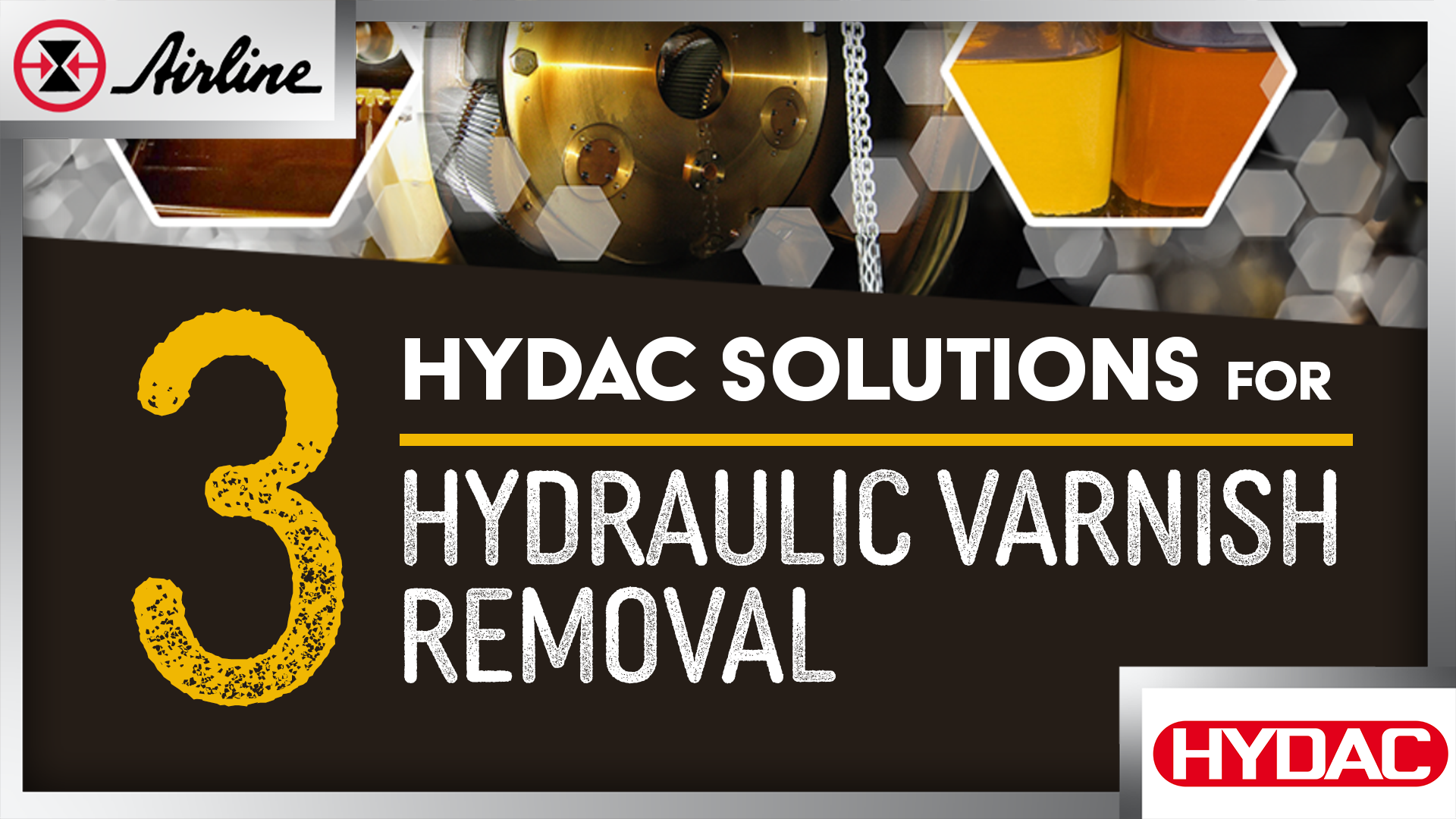Hydraulic systems are renowned for their versatility and reliability. However, they are not without complications. Complication number one is varnish buildup in hydraulic oils. This is a real concern, as it can compromise your systems, reducing their efficiency and shortening their lifespan. The longevity and performance of your hydraulic systems—not to mention your bottom line—hinge on addressing this issue effectively. So, what's the solution?
Today, we'll review solutions for removing varnish from hydraulic systems, ensuring your operations continue to run smoothly. By understanding how to tackle varnish buildup, you're not just maintaining equipment; you're investing in the continued success and efficiency of your operations.
Jump to a Section
The Problem of Varnish Buildup in Hydraulic Oils | Traditional Varnish Removal Methods Have Limitations | Revolutionizing Varnish Removal | Steps Towards Cleaner Hydraulic Systems
Register for the Hydraulic Varnish Mitigation 101 Webinar
Key Takeaways✔️ Varnish results from oil degradation and can lead to malfunctions, increased operating temperatures, sticking valves, reduced cooler efficiencies, and premature filter blocking in hydraulic systems.
|
The Problem of Varnish Buildup in Hydraulic Oils

Varnish is not just an inconvenience; it's a symptom of oil degradation, a complex mixture of oil oxidation products, contaminants, electrostatic discharges, and thermal degradation by-products. These substances combine to form sticky, varnish-like deposits that cling to hydraulic system components, causing malfunctions, increased operating temperatures, sticking valves, reduced cooler efficiencies, and premature filter blocking.
Understanding the formation and risks associated with varnish is needed for maintaining system efficiency. Hydraulic varnish removal and oil varnish mitigation are not just routine maintenance tasks; they are essential to ensuring hydraulic systems' reliability, performance, and longevity.
Traditional Varnish Removal Methods Have Limitations
In the quest for clean hydraulic systems, the manufacturing and power generation industries have used many methods to combat varnish, from conventional oil filtration to more sophisticated techniques. However, traditional methods have limitations, often failing to remove or even detect the varnish precursors effectively.
Conventional oil filters, for instance, are not designed to trap the molecularly small oxidation products that lead to varnish. Laboratory analysis techniques like particle counting and the Membrane Patch Colorimetry (MPC) test can identify varnish potential, yet they offer no solution to the removal challenge.
Top 3 Highlighted Solutions for Hydraulic Fluid Conditioning
-
1. The varnish buster - VEU (Varnish Elimination Unit)
HYDAC's Varnish Elimination Units (VEU) are designed to improve the condition of mineral oils. They excel at extracting oil degradation products, AKA varnish, from mineral oils. The VEU-F series operates on a bypass flow mechanism.
Key Features
- Efficient removal of both solid and gel-like varnish products.
- Enhances system reliability by minimizing deposit buildup on hydraulic valves.
- Prolongs the service life of fluids.
- Available as a comprehensive solution for both retrofitting existing systems and integrating into new installations.
Interested in this unit? Reach out to us! We provide both purchasing and rental options for fluid conditioning units.
VarnishElimination Unit – Filtration VEU-F Brochure
-
2. The heavy-hitter - OLF Offline Filtration Unit
Are you looking for an economical and smart way to keep large amounts of hydraulic and lubricating oils, cleaning fluids, and coolants clean? The HYDAC OLF series filtration units are what you need. These units, available in sizes from the OLF5 to OLF60, these units are tailored to meet diverse requirements efficiently.
The OLF series, including models 5/15/30/45/60, are sturdy bypass flow units designed for stationary use in systems handling large volumes of hydraulic and lubrication oils. They utilize Dimicron elements, known for their exceptional contamination retention capabilities and eco-friendly disposal options, as they are burnable.
Optional Integrated Fluid Sensors Enhance these bypass flow filters with an optional ContaminationSensor CS 1000 or an AquaSensor AS 1000 to simultaneously monitor solid particle contamination, water saturation, and temperature. Conveniently, the optional SMU 1200 SensorMonitoring Unit can display these measurements, which can be simply transferred to a PC via USB or integrated into a plant control system using analog outputs.
Key Specifications:
- Maximum housing volume: 78 liters
- Maximum operating pressure: 6 bar
- Enhances component and filter lifespan
- Boosts machine availability
- Prolongs oil change intervals
- Offers high serviceability
- Exceptional contamination retention by the filter elements
- Eco-friendly element disposal through incineration
- Integrated fluid sensors for comprehensive oil monitoring
These units work completely offline and include optional motor and pump units, leading to lower operational costs and a cleaner system. Used in many applications, such as filling and flushing hydraulic units, test stands, parts washing machines, and much more.
A standout feature of the OLF series is the incorporation of Dimicron® technology, which leverages membrane filtration and multi-disc construction for unmatched dirt-holding capacity and separation efficiency. The smaller filter model has the capacity to contain more than one pound of dirt, whereas the larger OLF-30 model, which is equipped with two filters, can hold close to two pounds. These units ensure excellent performance in a single pass, with a filtration efficiency of over 99.9% for particles two microns and larger.
Interested in renting this unit for fluid filtration? Visit our website and learn more!
-
3. The EHC master - IXU – Ion eXchange Unit
The IXU series offers service-friendly ion-exchange units designed for treating fire-resistant hydraulic and lubrication fluids, specifically those based on phosphate esters (HFD-R) and polyolesters (HFD-U). These units excel at removing acidic degradation products caused by hydrolysis and/or oxidation, as well as metal soaps found in the fluid. Suitable for use with flow rates up to approximately nine liters per minute, they operate in the bypass flow of hydraulic and lubricating oil tanks. The IXU models come in both mobile and stationary configurations.
Utilizing HYDAC’s proprietary Ion eXchange (IXE) elements filled with ion-exchanger resins, the IXUs offer an efficient solution for cleaning and maintaining Phosphate Ester (HFDR type) hydraulic fluids. These fluids, often used in EHC systems, offer superior fire resistance compared to traditional petroleum-based fluids but require meticulous care. This fluid conditioning cart is specifically designed to meet those needs.
Easy to integrate with existing hydraulic reservoirs, the carts provide continuous offline fluid conditioning, ensuring the oil used in steam-turbine EHC systems remains clean and functional. The filtration process employs physical adsorption and ion exchange to remove acidic byproducts, oxidation, and varnish from the HFDR-type hydraulic oil.
Ready to use, each unit includes a set of installed elements, suction and discharge hoses, an electrical cord and plug, a combined water removal and particulate filter element, and two IX-200 Ion eXchange cartridges.
Ion eXchange Unit IXU 1/4 Series Brochure
But wait, there’s more!
Our top three selections just scratch the surface of what HYDAC offers. Explore a wider array of fluid conditioning technologies.
If you’re interested in renting or purchasing a fluid conditioning unit, explore our website or contact us to learn about additional units that are available.
Steps Towards Clean Hydraulic Systems
The task of managing and mitigating the effects of varnish in hydraulic systems is complex, but with technological advancements and a better understanding of oil degradation processes, a varnish-free future is within reach. Want a more in-depth explanation and more resources? Register for our upcoming webinar, Hydraulic Varnish Mitigation 101, to learn more about innovative solutions and best practices in hydraulic varnish removal.
Frequently Asked Questions about Hydraulic Varnish RemovalWhat is the problem with varnish buildup in hydraulic oils?Varnish buildup in hydraulic oils, a complex mixture of oil oxidation products, contaminants, electrostatic discharges, and thermal degradation by-products, can lead to malfunctions, increased operating temperatures, sticking valves, reduced cooler efficiencies, and premature filter blocking. It's a symptom of oil degradation that affects hydraulic systems' efficiency, reliability, and longevity.
Why are traditional varnish removal methods limited?Traditional varnish removal methods, like conventional oil filtration, often fail to remove or even detect varnish precursors effectively. This is because these methods are not designed to trap the molecularly small oxidation products that lead to varnish.
How does varnish removal benefit my hydraulic systems and overall operations?Efficient varnish removal leads to improved performance, increased system availability, resource conservation, optimized costs, enhanced productivity, and significant maintenance cost reductions. It is essential for preserving the heart of your industrial operations. |








Leave Comment